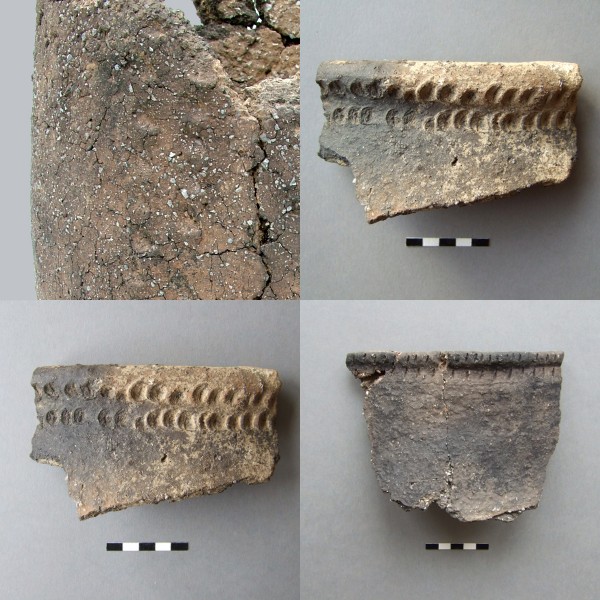
The image for Day 155 is of a nearly complete body and three rim sherds from four pottery vessels, all from excavations in Thanet and dating from the Middle Bronze Age, in the date range of c.1550-1350 BC.
The vessel on the top left is a Middle Bronze Age vessel from a cremation group in Ramsgate, which is decorated along its side with a single vertical row of marks from a finger tip. The three other rim sherds have a regular repeated pattern of decoration around the rim, made with a finger tip and finger nail. What inspired the potters who made these vessels to adopt this scheme of decoration?
Perhaps they used a model from some other part of their experience of the materials that were in common use in their community to generate a scheme of decoration which would be familiar to them and give prompts about what the appropriate functions of the vessels were and what uses they could be put to. The term skeuomorph is used to describe such decorative schemes that retain residual, but often completely redundant, elements from some other source. Even in our digital world we continue to make one thing look like another so that an object retains a familiarity and usability and helps us understand how the function of an object relates to what we know.
The decorative scheme on these contemporary Middle Bronze vessels may be skeuomorphs of the stitching that would have been required to create vessels from hard leather or perhaps another material that was less durable than pottery like the birch bark bucket found with the Egtved Girl who died in southern Jutland, Denmark and was buried in an oak log coffin, dated by dendrochronology to 1370 BC. The bucket held an alcoholic drink, probably a form of ale.

The various locations of the schemes around the rims and up the side of the Bronze Age pottery vessels from Thanet could be emulating the vertical join in soft material, like a hard leather tube or birch bark and the stitching that created a usable rim. The survival of a more varied range of material in more favourable archaeological contexts should help us understand how echoes of their familiar forms were preserved in the material that does survive in the more limited range of archaeological materials that can be recovered from Thanet’s dry chalk soils.